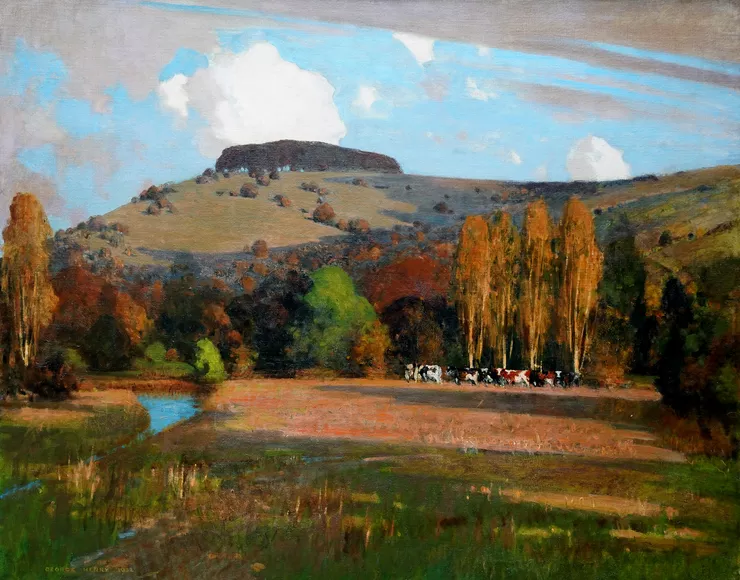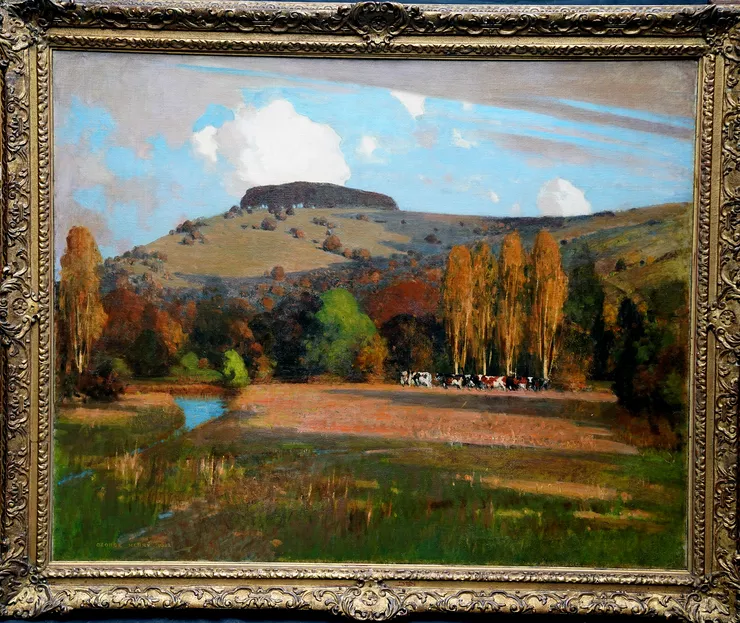George Henry (1858-1943)
| Artist Name | George Henry (1858-1943) |
|---|---|
| Title | Chanctonbury Ring |
| Description | This superb Scottish Impressionist Royal Academy exhibited landscape oil painting is by noted Scottish Glasgow Boy artist George Henry. He influenced the Glasgow School towards a richer more vibrant use of colour as can be seen in this painting. Painted in 1932, it was exhibited at the Royal Academy, London in 1933, entitled Chanctonbury Ring. The location is the well known landmark, Chanctonbury Ring, at the top of Chanctonbury Hill in Sussex (Please see an explanation below of how the Ring came to be and the folklore surrounding it). The landscape has tremendous depth and scale to it as one's eye is drawn across the fields and vivid blue river in the foreground, to the cows grazing before the colourful tree line and then up to the copper beech trees crowning the hill beneath a blue sky. The depiction of shadow and light on the field and hills is also superb. This is an excellent example of a Scottish Glasgow Boy painting with excellent provenance and has a wonderful tranquillity and spaciousness about it. Signed and dated 1932. Chanctonbury Ring is in a commanding position looking across the Sussex Weald to the north, on the edge of a steep natural escarpment to the northwest and northeast. Chanctonbury Ring is a large mound set high atop Chanctonbury Hill, crowning it are countless beech trees. These trees are a relatively recent addition. The story behind them is integral to understanding both the historical significance and folklore of the site. Sitting beneath the hill is Wiston House, which in the 18th Century was the seat of the Goring family. In 1760 Charles Goring, then a school boy, was overcome with an inexplicable desire to see Chanctonbury Ring capped with trees. Charles planted the trees in the same year and every day walked up the hill to water them. Many objected to the planting of the trees and the resulting change they made to the landscape. Charles proceeded undeterred; he wasn’t going to let a few complaints get in the way of his horticultural desires. All was well for a time, but in 1786 a new owner lay claim to the land by the traditional process of ‘treading in’. Charles refused to budge. The new ‘owner’ made an offer to pay for the land but was confounded by Charles’ obsession with the Ring. Letters went back and forth and eventually the interloper conceded ownership. Charles won the battle and kept his precious trees. |
| Provenance | Exhibited at the Royal Academy London in 1933 no. 157 and entitled Chanctonbury Ring. Illustrated on page 89 of the Royal Academy Illustrated guide. |
| Medium | Oil on Canvas |
| Size | 40 x 50 inches |
| Frame | Housed in an exhibition frame, 57 inches by 47 inches and in good condition. |
| Condition | Good condition. |
| Biography | George Henry (1858-1943) was a Scottish painter and one of the most prominent of the Glasgow School. He was born in Irvine, North Ayrshire, and studied at the Glasgow School of Art, later in Macgregor's studio, but learned most from his nature studies at Kirkcudbright. His father's name was Hendry and George dropped the "d" from his surname as a young man. He was influenced also by his collaboration with E. A. Hornel in such works as "The Druids" (1887), Grosvenor Gallery, London. His "Galloway Landscape" was epoch-making at Glasgow by reason of its higher key of colour and essentially decorative character. Following these tendencies, the two friends spent a year and a half in Japan. Henry's importance consists in his influence in the Glasgow school in the direction of richer and more decorative colour. In addition to genre and landscape, he also painted portraits, more distinguished by technical ability than by rendition of character. Henry's pictures in public collections include "The Blue Gown," Museum of Cape Town, "The Gray Hat," at Edinburgh, two portraits at Glasgow, and one at Montreal. He was elected a member of the Royal Scottish Academy (1902) and an associate of the Royal Academy. "The Black Hat", a luminous portrait of a supremely confident Edwardian woman, was recently included in Modern Britain, an exhibition at Melbourne's National Gallery of Victoria. |
| Price | SOLD |

